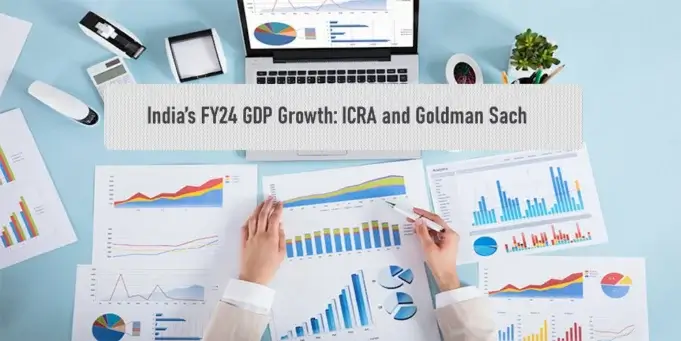ICRA’s Outlook:
According to ICRA, India’s GDP growth for the fiscal year 2024 (FY24) is expected to be around 6 percent. They anticipate a sequential decline in GDP growth, with the July-September 2023 quarter projected to be at 7 percent, down from 7.8 percent in the first quarter of the fiscal year. However, the second-quarter growth is expected to exceed the RBI’s Monetary Policy Committee’s (MPC) October 2023 projection of 6.5 percent. This moderation in GDP growth is attributed to factors such as a normalizing economic base and unpredictable monsoon patterns.
The Gross Value Added (GVA) growth is estimated to ease to 6.8 percent in the second quarter of FY24 from 7.8 percent in the first quarter. This shift is influenced by changes in different sectors, with Services dropping from 10.3 percent to 8.2 percent, Agriculture from 3.5 percent to 1.0 percent, and Industry improving from 5.5 percent to 6.6 percent. ICRA notes that factors like uneven rainfall, fluctuations in commodity prices, a potential slowdown in government expenditure leading up to parliamentary elections, weak external demand, and the cumulative impact of monetary tightening may contribute to lower GDP growth in the second half of FY24.
Despite these challenges, investment activity appears robust in the second quarter. Seven out of eleven investment-related indicators saw year-on-year growth improvements compared to the first quarter of FY24. While the remaining four indicators had a slower year-on-year growth rate in the second quarter, they still witnessed double-digit expansion. These indicators include commercial vehicle registrations, cement production, state governments’ capital outlay and net lending, and the Government of India’s capital expenditure.
ICRA also reports that industrial GVA growth increased from 5.5 percent in the first quarter to 6.6 percent in the second quarter of FY24, primarily driven by manufacturing, electricity, and mining. Manufacturing GVA is expected to improve from 4.7 percent to 5.5 percent in the second quarter. Additionally, electricity generation experienced a significant expansion of 11.1 percent year-on-year in the second quarter, benefiting from increased electricity demand due to sub-par monsoon rainfall.
Goldman Sachs Report:
Goldman Sachs predicts that India’s real GDP growth rate will slightly moderate to 6.3 percent in FY24, down from an estimated 6.4 percent growth in FY23. They expect this moderation to occur in two phases. In the first half of the year, subsidies and transfer payments are anticipated to drive growth, especially as India approaches general elections in Q2 2024. Post-elections, Goldman Sachs foresees a resurgence in investment growth, particularly from the private sector.
While the government is expected to maintain its focus on capital spending, the rate of growth in capital expenditure is likely to decrease in the next fiscal year due to medium-term fiscal consolidation goals. Risks to the growth outlook are seen as balanced, with potential political uncertainty as the main domestic risk, given the approaching elections.
Goldman Sachs also predicts that inflation is likely to remain above the Reserve Bank of India’s (RBI) target of 4.0 percent in 2024, with a forecasted headline CPI inflation of 5.1 percent year-on-year (average) in 2024. They expect the government to intervene through subsidies or other measures to control food prices in an election year. Core inflation is also expected to decline from 5.1 percent in 2023 to 4.5 percent in 2024.
Regarding monetary policy, Goldman Sachs anticipates only a 50 basis points cut by the RBI to 6.00 percent by early 2025. They suggest that a global scenario of higher interest rates and elevated domestic inflation will lead to continued hawkish guidance from the RBI and tight banking system liquidity.
In terms of the current account deficit, Goldman Sachs predicts an increase by 60 basis points to 1.9 percent of GDP in 2024. They expect foreign portfolio inflows, driven by India’s inclusion in a global bond index, to help fund the current account deficit.











